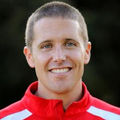There are standard terms used across the fitness industry, but each club will likely have its own lingo. The list below includes lingo commonly heard in fitness facilities, along with definitions. The more you know, the more likely you will go!
Acronyms
AMRAP: As many reps/rounds as possible in a given time.
EMOM: Every minute, on the minute. A set number of reps are performed at the start of every minute.
HIIT: High-intensity interval training. Short, intense work periods provide improved athletic capacity and metabolism.
TRX®: Total Body Resistance Exercise. Refers to yellow and black straps you might see anchored to the wall or a rack used for bodyweight and suspension training.
BOSU®: Both sides up. The BOSU® is a half sphere. One side is flat and rigid, and the other side is a pliable ball. BOSU® is often used for balance or core training. Note: BOSU® recommends standing only on the dome side of the equipment.
DOMS: Delayed onset muscle soreness. Discomfort and stiffness experienced in the muscles hours or days after performing an exercise with unaccustomed loads or movements. Many people experience the effects of DOMS 1-3 days after exercise.
BMR: Basal metabolic rate. The amount of energy expended while at rest in order to perform biological functions. In general, the more muscle mass one has, the higher the BMR.
BMI: Body mass index. BMI is a person's weight in kilograms (kg) divided by his or her height in meters, squared. BMI should be used in conjunction with other measurements for best results.
WOD: Workout of the day.
Methods
Lifting weights: General resistance training with a variety of exercises and equipment. This is what most people do for strength training in the gym.
Weightlifting: Competitive sport focusing specifically on the execution of the snatch, clean and jerk movements.
Powerlifting: Competitive sport focusing on the deadlift, bench press and squat.
Functional training: Compound or multi-joint exercises or movements used to prepare the body for everyday life.
Group fitness: Mode specific, often choreographed classes such as indoor cycling, Zumba, aqua, or group strength training, where the instructor leads by demonstrating exercises.
Group training: Smaller, semi-private group in which the trainer leads by coaching. Group training often occurs on the main, public floor of a fitness center.
Circuit: Performing a series of exercises, moving from one exercise to the next with little or no rest.
Super set: Two exercises performed in alternating fashion.
Intervals: A set amount of time in work, followed by a set amount of time in rest.
Tabata: A method of interval training invented by Dr. Izumi Tabata. Eight rounds of 20-second, high intensity work intervals, followed by 10 seconds of rest.
Equipment and other terms
Kettlebell: Cast iron weight equipment in the shape of a bell. Used for swings, lifts and carries.
Medicine ball: Firm, weighted ball often used for throwing and catching with resistance. Not designed for slamming on the ground. There are pliable balls called slam balls made specifically for slamming.
Selectorized machines: Weight machines where you can easily select a weight by inserting a pin in the weight stack. These machines are sometimes called circuit machines.
Free weights: Dumbbells or other equipment used freely or without the guidance of a machine or cable.
Collar: The attachment that secures plate weights on a barbell, so the weight doesn’t slip off.
Foam roller: A long, cylinder made of foam used for soft tissue massage (which is often called myofascial release).
Elliptical: Cardio machines that create a range of motion that follows an elliptical pattern, reducing impact to joints.
Spot: Watching and/or assisting someone as they perform a loaded exercise to minimize risk.
Rep: One complete motion of an exercise.
Set: A group of consecutive repetitions.
Core: The central most part of the body. In fitness, it means the area between the legs and arms. Core training often focuses on training the abdominals, but can also include back, hip and shoulder training.
These words are a short sampling of the many phrases used in the fitness culture. Each gym will have its own subculture and language specific to its niche, location and membership. The fitness culture continues to evolve. If there is a word, phrase or acronym that you don’t know or don’t understand, ask a trainer or the person at the front desk.




 by
by 



 by
by